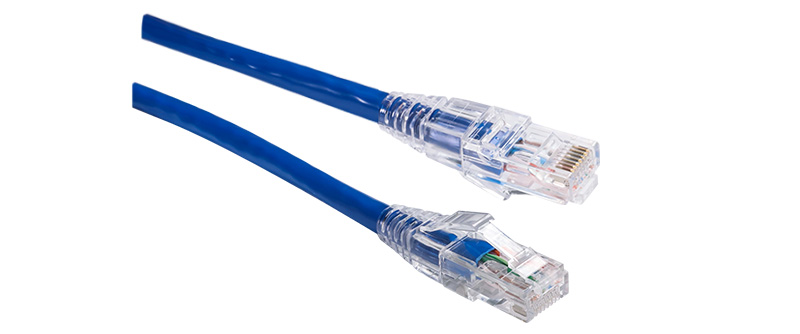Flat Ethernet Cable vs Round Cable, What is the Difference?

Flat Ethernet cable vs round cable: two options with a single purpose - transmitting data. But what sets them apart? In this article, we'll unravel the dissimilarities between flat cable and round cable. Join us as we explore the distinctive features of each cable type and delve into the world of flat vs. round Ethernet cables to help you make an informed choice for your networking needs. This article will use Cat6 cable as an example to help you determine the difference between flat Internet cable and round ethernet cable.
What are Flat Cat6 Cables?

Definition of Ethernet Flat Cables
Cicoil, the pioneer of Ethernet flat cables, originally designed them for IBM computers, aiming for easy packaging, user-friendliness, reduced electronic noise, and minimized vibration during operation. These cables feature side-by-side twisted pairs, forming a flat shape with copper wire.
Due to the inherent design challenges, Cat6 cable flat type are mostly unshielded, making external EMI protection difficult to implement. However, this lack of insulation and shielding contributes to their affordability, lightweight nature, and ease of rolling up or packaging compared to round cables.
The Main Characteristics of Flat Ethernet Cables
Superior electrical quality conductivity
Cat6 flat cables demonstrate outstanding electrical quality conductivity by positioning the conductors in a side-by-side configuration. Unlike round cables, the electrical quality of flat cables remains constant, which is a notable achievement.
Convenient Storage and Installation
Ethernet flat cables offer reduced volume and weight, making them easier to store and install.
Cost Advantage
Generally speaking, flat Ethernet cables cost less than round cables in terms of exact length and category.
Maintenance and Crosstalk Challenges
The absence of exterior protection and shielding in flat Cat6 cables necessitates increased maintenance due to their structure. Additionally, they exhibit higher levels of crosstalk, resulting in electromagnetic interference between wires.
What is a Round Cat6 Cable?

Definition of Round Ethernet Cables
The round Cat6 Ethernet cable is formed by wrapping insulated copper wires in a circular configuration, along with multiple layers of fillers that provide complete shielding. These fillers reinforce the cable's round shape while reducing the heat generated by friction within the Ethernet cable.
These cables are widely used in data and telecom centers and in residential and office environments where wired networks are required. They are particularly useful in scenarios such as running cables through walls or requiring extended cable lengths, as their shielding effectively protects against interference.
The Main Characteristics of Ethernet Round Cables
Perfect for PoE Devices
Round Cat6 cables, featuring robust construction and effective shielding, are ideal for Power over Ethernet (PoE) devices. Their ability to produce less heat makes them suitable for such applications.
User-Friendly
Round cables possess a combination of desirable traits, including flexibility, simplicity of installation, and durability. These user-friendly characteristics contribute to their appeal and practicality in various applications.
Enhanced Uptime and Longevity
Round Ethernet cables have a higher uptime or operating level. They exceed the life of flat Ethernet cables.
Higher Price
Ethernet Cat6 Round cables come at a significantly higher price point than flat cables.
QSFPTEK offers a variety of round Ethernet cable types, including Cat5e, Cat6, Cat6a, Cat7, and Cat8, as shown in the table below.
Flat vs Round Ethernet Cable, What is the Difference?
To simplify your decision-making process, let us provide you with a comprehensive comparison between round and flat Ethernet cables. By the conclusion of this analysis, we aim to empower you to select the most suitable cable shape for your specific needs.
The table below shows the difference between a flat Ethernet cable and a round Ethernet cable.
Ethernet Cable Flat vs Round, Which one is Better for You?
In general, there are notable distinctions in terms of appearance, durability, and cost between flat and round Ethernet cables. When choosing the proper cable for your requirements, it is important to take factors such as cable length, space limitations, and frequency of usage into consideration. Ultimately, consider the cable type compatibility with your specific needs.
In the case of typical home and small network configurations, there is usually minimal disparity, and you can freely select the type of cable you find most comfortable or already possess. The choice between the two kinds does not significantly impact performance or functionality.
If you plan to install ethernet cables in a data center for long-distance connections or if you need to thread the cables through existing walls, round cables are generally considered a more suitable option.
If cost-effectiveness is a priority for you, you are not concerned about lower durability and prefer enhanced cable management options. Flat Ethernet cables may be the preferred choice for your installation.
Before choosing between flat and round Ethernet cables, it is essential to carefully evaluate the advantages and disadvantages, consider your existing cables, and fully understand what is appropriate for your specific application.
Conclusion
Flat cables offer advantages in flexibility, space-saving design, and ease of cable management. On the other hand, round Ethernet cables excel in durability, suitability for longer distances, and installations in data centers or walls. The choice between flat Ethernet cables and round cables ultimately depends on your specific needs, preferences, and the demands of your networking environment. Flat vs round Ethernet cable, what is your choice? QSFPTEK lists a wide range of round Ethernet patch cables on the website. You can also contact our support for a quotation if you need flat cables, such as flat cat5e cable.










